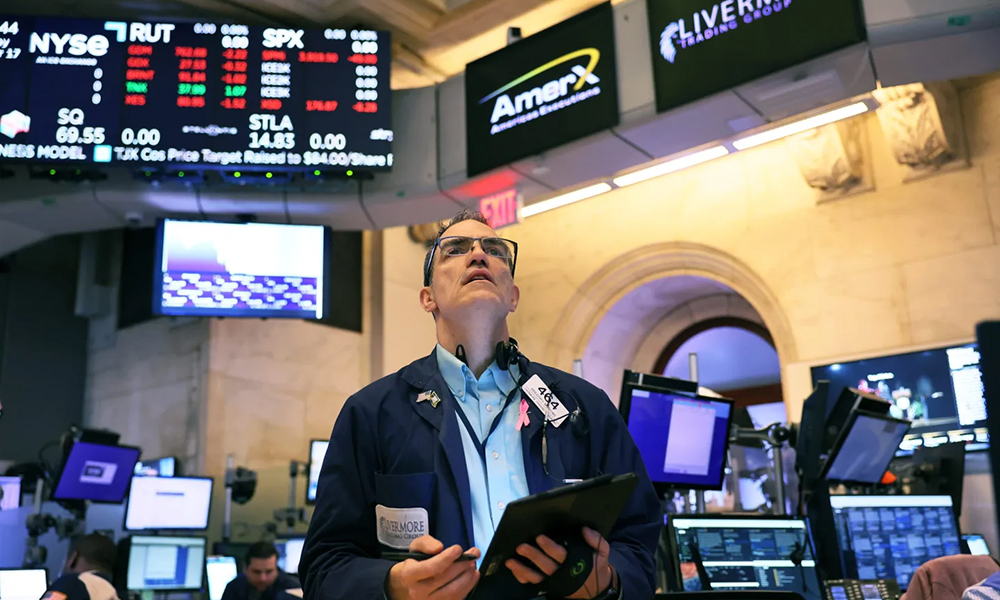
瑞銀全球財富管理公司(UBS Global Wealth Management)表示,"通貨緊縮"將成為2023年金融界的"年度關鍵詞"。
考慮到6月份通貨膨脹率達到9.1%的40年高點,這是一個大膽的選擇,但大多數經濟學家如今認為,消費價格漲幅已經見頂。
在通貨膨脹率超過9%后的幾個月里,汽油價格下跌了近40%,房地產市場暴跌,商品價格整體開始降溫。
因此,美國上個月的通貨膨脹率同比下降至7.1%,盡管這仍遠高于美聯儲2%的目標通脹率,但瑞銀全球財富管理公司美洲資產配置主管杰森·德拉霍(Jason Draho)認為,通貨膨脹“可能會在2023年上半年持續快速下降”。
"通貨緊縮已經發生了。"他在12月16日的研究報告中寫道。"未來會出現通貨緊縮,這一點毋庸置疑,爭論的焦點是未來通貨緊縮的嚴重程度。"
德拉霍說,明年經濟學界的主要爭論是,如果與目前預期相比,不再持續進行加息,通脹是否會回落到美聯儲2%的目標,或者通脹是否會在4%左右"觸底"。
但他明確表示,選擇"通貨緊縮"作為2023年的年度關鍵詞(或稱WOTY),并不是預測。
他寫道:“預測通貨緊縮將成為明年最主要的市場故事,并不是預測會出現嚴重的通貨緊縮,到年底通脹將恢復到2%的目標通脹率。但正如美聯儲收緊金融環境推動了今年整個金融市場的表現一樣,潛在的通貨緊縮可能在2023年起到同樣的作用。如果這都不是金融界年度關鍵詞的秘訣,那就沒有什么是了。”
德拉霍繼續闡述了選擇 "通貨緊縮"作為年度關鍵詞的幾大關鍵原因。
首先,他說,美國經濟通貨緊縮的程度對美聯儲的政策至關重要。為了給經濟降溫并抑制通貨膨脹,美聯儲今年已經七次加息。
德拉霍寫道:“結構性通縮越嚴重,美聯儲就可以越早停止加息并開始降息。”
其次,他認為,過去一年,美聯儲已成為投資者最重要的變量。利率上升使得風險投資吸引力下降,導致一度高漲的科技股和加密貨幣價格大幅下跌,但這種情況可能在2023年發生轉變。
“美聯儲從投資者的敵人變成朋友,這是明年值得關注的拐點。”他寫道。
再次,德拉霍描述了明年通貨緊縮的嚴重程度將如何決定美國經濟是否能實現“軟著陸”,即在沒有衰退的情況下抑制通貨膨脹。
最后,雖然2023年年度關鍵詞的另一個明顯選擇可能與經濟衰退相關,比如“軟著陸”或“硬著陸”,但德拉霍說,關于經濟衰退的爭論實際上是“語義”方面的問題。
“這兩種情況都可能導致盈利衰退。”他表示。“然而,大幅通縮與小幅通縮在宏觀上存在巨大差異。”(財富中文網)
譯者:中慧言-王芳
瑞銀全球財富管理公司(UBS Global Wealth Management)表示,"通貨緊縮"將成為2023年金融界的"年度關鍵詞"。
考慮到6月份通貨膨脹率達到9.1%的40年高點,這是一個大膽的選擇,但大多數經濟學家如今認為,消費價格漲幅已經見頂。
在通貨膨脹率超過9%后的幾個月里,汽油價格下跌了近40%,房地產市場暴跌,商品價格整體開始降溫。
因此,美國上個月的通貨膨脹率同比下降至7.1%,盡管這仍遠高于美聯儲2%的目標通脹率,但瑞銀全球財富管理公司美洲資產配置主管杰森·德拉霍(Jason Draho)認為,通貨膨脹“可能會在2023年上半年持續快速下降”。
"通貨緊縮已經發生了。"他在12月16日的研究報告中寫道。"未來會出現通貨緊縮,這一點毋庸置疑,爭論的焦點是未來通貨緊縮的嚴重程度。"
德拉霍說,明年經濟學界的主要爭論是,如果與目前預期相比,不再持續進行加息,通脹是否會回落到美聯儲2%的目標,或者通脹是否會在4%左右"觸底"。
但他明確表示,選擇"通貨緊縮"作為2023年的年度關鍵詞(或稱WOTY),并不是預測。
他寫道:“預測通貨緊縮將成為明年最主要的市場故事,并不是預測會出現嚴重的通貨緊縮,到年底通脹將恢復到2%的目標通脹率。但正如美聯儲收緊金融環境推動了今年整個金融市場的表現一樣,潛在的通貨緊縮可能在2023年起到同樣的作用。如果這都不是金融界年度關鍵詞的秘訣,那就沒有什么是了。”
德拉霍繼續闡述了選擇 "通貨緊縮"作為年度關鍵詞的幾大關鍵原因。
首先,他說,美國經濟通貨緊縮的程度對美聯儲的政策至關重要。為了給經濟降溫并抑制通貨膨脹,美聯儲今年已經七次加息。
德拉霍寫道:“結構性通縮越嚴重,美聯儲就可以越早停止加息并開始降息。”
其次,他認為,過去一年,美聯儲已成為投資者最重要的變量。利率上升使得風險投資吸引力下降,導致一度高漲的科技股和加密貨幣價格大幅下跌,但這種情況可能在2023年發生轉變。
“美聯儲從投資者的敵人變成朋友,這是明年值得關注的拐點。”他寫道。
再次,德拉霍描述了明年通貨緊縮的嚴重程度將如何決定美國經濟是否能實現“軟著陸”,即在沒有衰退的情況下抑制通貨膨脹。
最后,雖然2023年年度關鍵詞的另一個明顯選擇可能與經濟衰退相關,比如“軟著陸”或“硬著陸”,但德拉霍說,關于經濟衰退的爭論實際上是“語義”方面的問題。
“這兩種情況都可能導致盈利衰退。”他表示。“然而,大幅通縮與小幅通縮在宏觀上存在巨大差異。”(財富中文網)
譯者:中慧言-王芳
“Disinflation” will be the finance world’s “word of the year” in 2023, UBS Global Wealth Management says.
It’s a bold choice considering inflation reached a four-decade high of 9.1% in June, but most economists now believe consumer price increases have since peaked.
In the months since inflation topped 9%, gas prices have dropped nearly 40%, the housing market has tumbled, and prices for goods overall have begun to cool.
As a result, year-over-year inflation fell to 7.1% last month, and although that’s still well above the Federal Reserve’s 2% target rate, Jason Draho, head of asset allocation for the Americas at UBS Global Wealth Management, believes that inflation is “likely to continue falling rapidly in the first part of 2023.”
“Disinflation is already happening,” he wrote in a Dec. 16 research note. “That there will be disinflation is not really in dispute at this point, the debate is over how much disinflation there will actually be.”
The major argument in economics circles next year will be whether inflation will fall back to the Fed’s 2% target without more interest rate hikes than are currently expected, or if inflation will “hit a floor” at around 4%, Draho said.
But he made it clear that choosing “disinflation” as his word of the year, or WOTY, for 2023 isn’t a forecast.
“Predicting that disinflation will be the most dominant market story next year is not a prediction for significant disinflation, with a return to 2% inflation by year-end,” he wrote. “But just as the Fed tightening financial conditions is what drove performance across financial markets this year, potential disinflation could do the same in 2023. If that’s not a recipe for a finance WOTY, then nothing is.”
Draho went on to lay out a few key reasons for selecting “disinflation” as his word of the year.
First, he said that the amount of disinflation in the U.S. economy will be critical for Federal Reserve policy. The Fed has raised interest rates seven times this year in an attempt to cool the economy and tame inflation.
“The more rampant and structural disinflation is, the sooner the Fed can stop hiking rates and start cutting,” Draho wrote.
Second, he argued that the Fed has become the most important variable for investors over the past year. Rising interest rates have made risky investments less attractive, leading to major price declines in once high-flying tech stocks and cryptocurrencies, but that could shift in 2023.
“[A] Fed that goes from investor foe to friend is the inflection point to watch next year,” he wrote.
Third, Draho described how the amount of disinflation next year will determine whether the U.S. economy will be able to achieve a “soft landing”—where inflation is tamed without a recession.
And finally, while the other obvious choice for word of the year in 2023 might be recession-related—like “soft landing” or “hard landing”—Draho said the debate over what a recession might look like is really about “semantics.”
“Both could entail negative earnings growth,” he said. “Whereas there is a big macro difference between a lot versus a little disinflation.”






